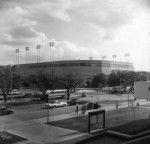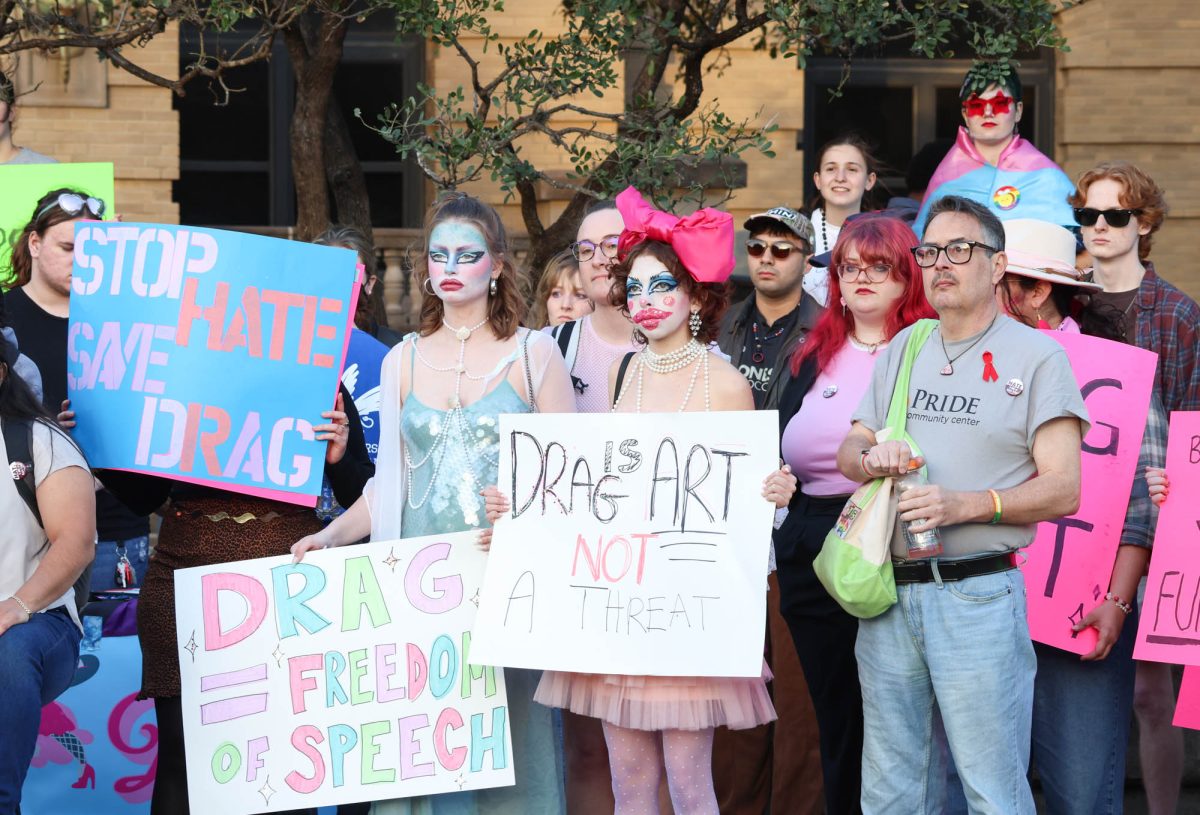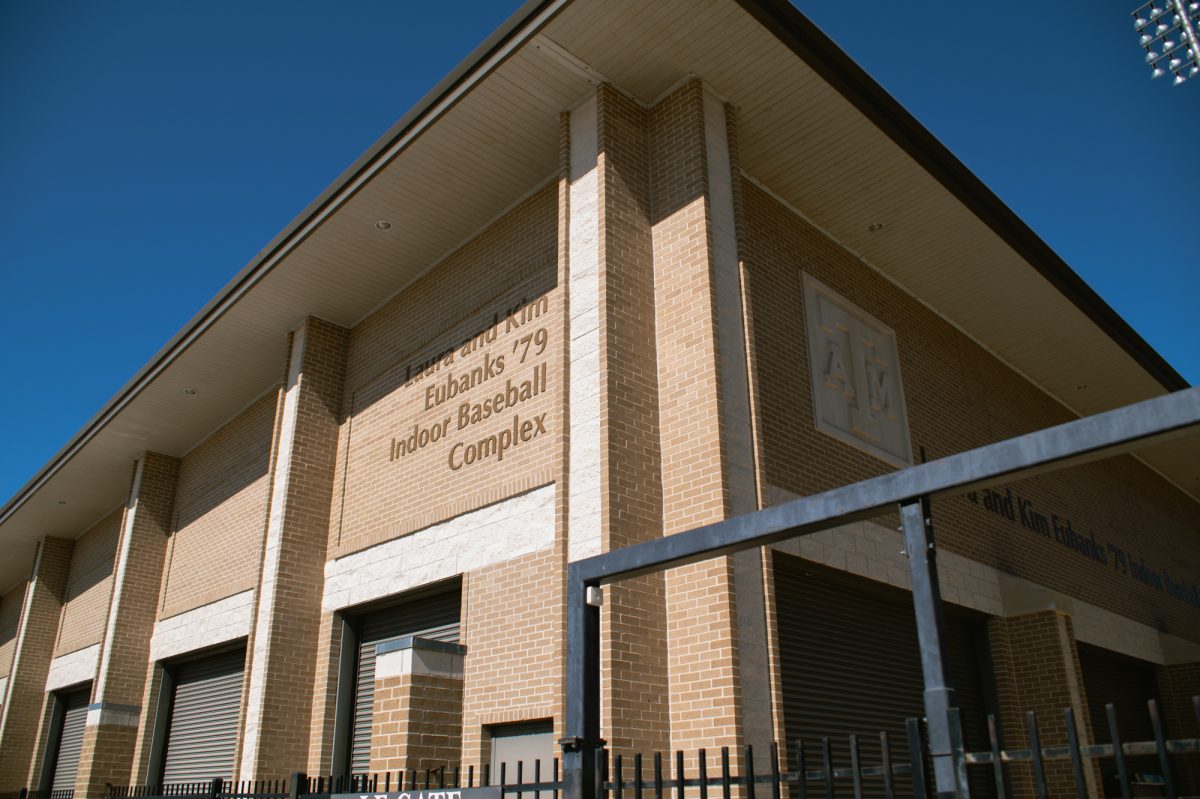Seen by some as an office or classroom, by others a sports arena and still others as a bookstore, for 59 years G. Rollie White Coliseum has served in many roles on campus.
It was erected in 1954 as a symbol of peace, hope and change. As written in “A Centennial History of Texas A&M University,” the decade of its inception “marked a time of relative tranquility” at A&M – compared to the Depression decade, war years and war reconstruction years – but also a concern for “things that were clearly coming, but were not yet quite here,” such as coeducation, elective military training and a regular student body.
Then-University President David H. Morgan, under recommendation from a faculty committee, decided at that time that instituting noncompulsory military training was the best solution to combat the declining enrollment at A&M. He also wanted to move Corps freshman into Corps dorms and civilian freshman into civilian dorms. The Board of Directors agreed.
“For the first time in its peacetime history, there is established a division in the organization of the student body,” said Tyree L. Bell, chairman of the G. Rollie building committee and Board of Directors member, at the coliseum’s dedication ceremony. “Can they be kept together in one united spirit, with a partisan loyalty to each other and the college itself, and to the ideals for which it was created? I believe this building can be made to serve that purpose.”
And with his next closing words, Bell set the standard for this structure at the heart of campus as a place where relationships were started and memories were made.
“Let us today dedicate this coliseum, The G. Rollie White Coliseum, as a citadel to Aggie Spirit, a shrine where all Aggies – students, alumni, college staff and faculty, friends – all may come and find inspiration to perpetuate the Spirit of Aggieland.”
Wednesday marked the first time that the facility would no longer be open to the public, and it is scheduled for demolition Aug. 19 to make room for the renovation of Kyle Field.
In The Beginning
Built as a replacement to an outdated and useless DeWare Field House, G. Rollie’s construction foreshadowed it’s own demise.
The coliseum was named after Board of Directors president G. Rollie White. At the time it was considered a state of the art facility and was called a “football stadium with a roof over it.”
For Thomas Miller, a yell leader in 1957-58, it was more than just the largest building on campus.
“It was a large building, probably the largest I had ever been in [at the time],” Miller said. “It would hold seven or eight thousand, which was everyone in the Corps and everyone in the school at the time.”
Miller recalled A&M not having a “very good team” at the time. Aggie basketball went 4-20 in its first season in G. Rollie White. During Miller’s yell leader days, the team was getting better at 11-13.
In those initial years of existence, the coliseum served as more than just a basketball court. Concerts at full capacity were held on campus for the first time.
One could say it was “fit for a king,” as Elvis Presley played a concert on its floor in 1955. Joining him was Johnny Horton, whose cover of “The Battle of New Orleans” still graces the Dixie Chicken from time to time.
Advance tickets were 75 cents. They sold for a dollar at the door.
“We saw some pretty good programs,” Miller said. “Elvis was there the year before I got [to campus]. He wasn’t famous yet. I think it was on record that the Aggies liked him but he wasn’t famous yet. That took another year.”
The King of Rock and Roll not only played on the same floor, but he even changed in the same dressing room that Aggie basketball and later Aggie volleyball players called home.
The Holler House
The memorable moments were just beginning at G. Rollie when Shelby Metcalf was hired as head coach of the men’s basketball team in 1963 after serving five seasons as an assistant coach.
Metcalf, who died of cancer in 2007, started a winning tradition in his first season at A&M, winning the Southwest Conference and advancing to the NCAA Regional Quarterfinals.
It was during this period that students began flocking to games where there was a new building with champion-caliber play.
“It was the greatest place to play basketball in the history of the world,” Metcalf told The Battalion in 1998. “I don’t know if the other coaches had the same feelings about the place.”
As the calendar turned to the 70s, Metcalf brought added attention to his crowds. In 1974 he earned his doctorate from A&M in recreation and resource development, with a dissertation titled, “Crowd Behavior at Southwest Conference Games.”
It was during that time that Metcalf recruited junior college star John Thornton, who was the SWC Newcomer of the Year in 1973-74. Thornton’s father was a yell leader who graduated in 1950, so he was no stranger to G. Rollie White.
“Back in the day [our family] would come to A&M football games from San Antonio and they would have tickets,” Thornton said. “My brother and I, we wouldn’t have tickets, but we could get in at halftime when they let the gates open. Before half we’d go to the top of G. Rollie and there were windows up there and you could see into Kyle Field. So, we could watch the game up top of G. Rollie and into Kyle Field as long as the action was at one end of the field. Then when [the half] was over with, we would run in to see the band and everything.”
In his senior year, Thornton was team captain and led the Aggies to a Southwest Conference title. That year the attendance record was set on Feb. 15 against Arkansas when 8,608 packed in the seats. Another 1,700 watched the game on closed circuit television from Rudder Tower Auditorium.
The paying attendance of 10,308 were watching what would become known as the “Shot Heard ‘Round the Conference,” as Tim Floyd hit the game-winning basket with seconds remaining for a 62-60 win.
“The entire band was in there and that whole wall was aluminum so it just reverberated in there,” Thornton said. “When they turned off all the lights and had just that spotlight to introduce the starting lineup you couldn’t even hear yourself: literally. Goosebumps upon goosebumps.”
That’s when G. Rollie White Coliseum changed. No longer was it a symbol only of hope, but a symbol of intimidation opponents feared. It had officially become the “Holler House on the Brazos” as it would be remembered for years to come.
Dark Days
In 1978, The Battalion wrote an editorial calling for a new coliseum. Houston, Arkansas and Texas were all advancing their programs with new arenas and A&M was falling behind.
Upon Metcalf’s departure in 1990 the University started to splinter, with some wanting a new venue and others wanting to spend countless dollars to keep the “Holler House” at the center of campus.
In 1993, a $30 million renovation became a possibility, but it was beat out by what would become Reed Arena. Reed Arena was built for $36.7 million on A&M’s west side of campus, and brought with it the struggling basketball team that had seen just one winning season since Metcalf was fired.
The move did open G. Rollie to the Aggie volleyball team, who took over the basketball locker rooms as the venue became a volleyball-only space.
“G. Rollie was a big reason why we were impressed with the Aggie program,” head volleyball coach Laurie Corbelli said. “The size of the facility and the term ‘Holler House’ made it sound like such a great place to have a home event.”
Corbelli was hired in 1993 and said she was happy to have G. Rollie as a volleyball-only facility in 1998, but that too changed in 2009 when the court became home to the University Bookstore during the MSC renovation process.
“I think former players were who I heard from the most – who couldn’t believe we were, in their eyes, kicked out of G. Rollie,” Corbelli said. “When they’d come to campus they couldn’t go to G. Rollie. They’d walk up the ramp and would just leave once they saw the bookstore.”
When the team moved to Reed Arena to accommodate the bookstore they never returned, marking one of the final changes of G. Rollie’s existence.
The End
In the days before the building was closed, current and former students could be seen walking around G. Rollie White Coliseum, taking pictures and reminiscing one last time.
“I’ve been around here so long and the campus has played such a big part in my life, and my family’s life, that I hadn’t been back through it until my daughter, who is 28-years-old, called me and said, ‘I want to go through it one more time with you,'” Thornton said. “It’s really hitting me. You’ll have pictures but you’ll never be able to step foot in it. We had so many stories and memories that came flooding back. I’m so glad I got to do that and that she took the initiative to say, ‘Dad, that meant so much to us as a family. Let’s go through it one more time.'”
Both Thornton and Corbelli got emotional when talking about the memories associated with Jolly Rollie, as it was also nicknamed. Many former students have commented that their first date as an Aggie happened in those bleachers.
Some met their future spouses just feet from the action of Metcalf, Thornton and Corbelli.
“I kind of raised my kids in G. Rollie so my son, Russell, used to play on the ramps and play with Alex Caruso, who’s a [now] sophomore on the basketball team,” Corbelli said.
Upon a final walk into the facility, the smell of cigars smoked by coaches in the building’s early existence still radiates. The clattering of the air conditioning installed in the late 60s is overheard from the rafters to the hallways.
“We’re all sad to see it go but they need to make room for the new stadium expansion,” Miller said.
In recent weeks, members of the Health and Kinesiology department have moved out. So too has the Letterman’s Association and finally the volleyball team, which held its youth camp through Tuesday.
“For me coaching is all about my players and I think about just how much that building, that environment, G. Rollie played a role in our lives from 1993 to ’08,” Corbelli said. “The All-Americans, the blood on the floors, the times I sent them into the bleachers to run. I’ll have to fight the feeling that those years are gone. Those memories are going to be that much more important. I wouldn’t doubt it if it spend some of my evenings during the season looking through pictures of those years.”
Corbelli said she hopes to get a piece of the court as one of many items that will be auctioned off by the University upon the building’s demolition.
Now just a skeleton of what it once was, G. Rollie has been a signal for hope and continual change to some, for others, a noisy “Holler House” where games were won and lost.
But beginning in August, G. Rollie White Coliseum will become but a memory – much like the ones it helped create through 59 years.
Holler House on the Brazos’
July 24, 2013

0
Donate to The Battalion
$1765
$5000
Contributed
Our Goal
Your donation will support the student journalists of Texas A&M University - College Station. Your contribution will allow us to purchase equipment and cover our annual website hosting costs, in addition to paying freelance staffers for their work, travel costs for coverage and more!
More to Discover









